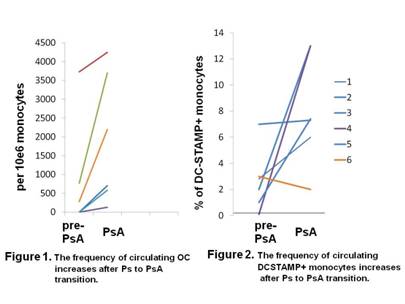Session Information
Session Type: Abstract Submissions (ACR)
Background/Purpose: Approximately 20% of psoriasis (Ps) patients (pts) develop psoriatic arthritis (PsA). Early diagnosis and therapy of PsA can limit bone and joint damage; however, biomarkers to detect subclinical joint inflammation are not available. Osteoclasts (OC) are specialized cells circulating in the blood and responsible for bone erosion in erosive arthritis. We previously showed that osteoclast precursors (OCP) are elevated in a subset of Ps pts and that DC-STAMP (Dendritic Cell-Specific Transmembrane protein), a protein expressed on the surface of monocytes, is a reliable OCP marker. To examine if the transition from Ps to PsA is associated with a change in OCP frequency and the percentage of monocytes that express DC-STAMP, we monitored these 2 parameters on Ps patients before and after the onset of arthritis.
Methods: We follow over 132 Ps patients at the Rochester site in the International Psoriatic Arthritis Research Team (IPART) registry. Ps was confirmed by a dermatologist and PsA was diagnosed by a rheumatologist based on the CASPAR criteria. Blood samples were collected at baseline and after Ps pts developed PsA. To analyze DC-STAMP expression, cells were purified from blood by Ficoll gradient, stained with anti-DC-STAMP and anti-CD14 antibodies, and analyzed by flow cytometry. To enumerate OCP, cells were cultured in OC-promoting media and TRAP-stained. Cells with ≥3 nuclei  were counted as OC.
were counted as OC.
Results: Over the past year, 6 Ps pts at our site developed PsA. The average Ps duration year was 28.7±17.9, Tender Joint Counts were 8.3±6.7 (prior) and 16±15 (after), Swollen Joint Counts were 3.9±4.1 (prior) and 7.1±9.6 (after), PASI scores were 4.7 ± 3.5 (prior) and 2.0 ± 1.1 (after). Of the 6 pts who developed PsA, 5 had scalp psoriasis, 4 had nail disease, 4 had a family history of psoriatic disease and a history of prior trauma. Two of these patients had baseline radiographic erosions. A significant increase in the frequency of OCP was observed at the time of arthritis onset in all patients (Fig 1), whereas an increase in the percentage of DC-STAMP+ monocytes was detected in 4 of 6 pts (Fig 2).
Conclusion: The progression of Ps to PsA was associated with a dramatic increase in circulating OCP numbers accompanied with an elevated DC-STAMP+CD14+ monocyte frequency. Collectively, our results suggest that the OCP numbers as well as the frequency of circulating DC-STAMP+ monocytes in the blood are potential arthritis susceptible biomarkers in Ps patients.
Disclosure:
Y. H. Chiu,
None;
E. M. Schwarz,
None;
D. D. Gladman,
None;
S. Moorehead,
None;
M. Smith,
None;
R. Barrett,
None;
C. T. Ritchlin,
None.
« Back to 2012 ACR/ARHP Annual Meeting
ACR Meeting Abstracts - https://acrabstracts.org/abstract/the-transition-from-psoriasis-ps-to-psoriatic-arthritis-psa-is-associated-with-elevated-circulating-osteoclast-precursors-ocp-and-increased-expression-of-dc-stamp/
